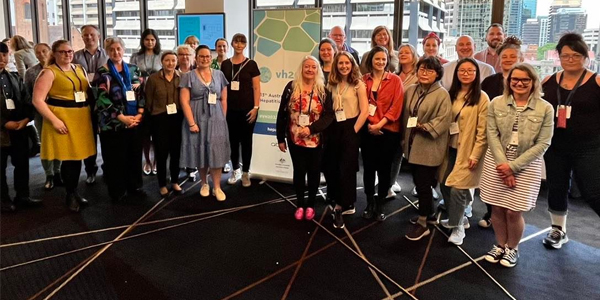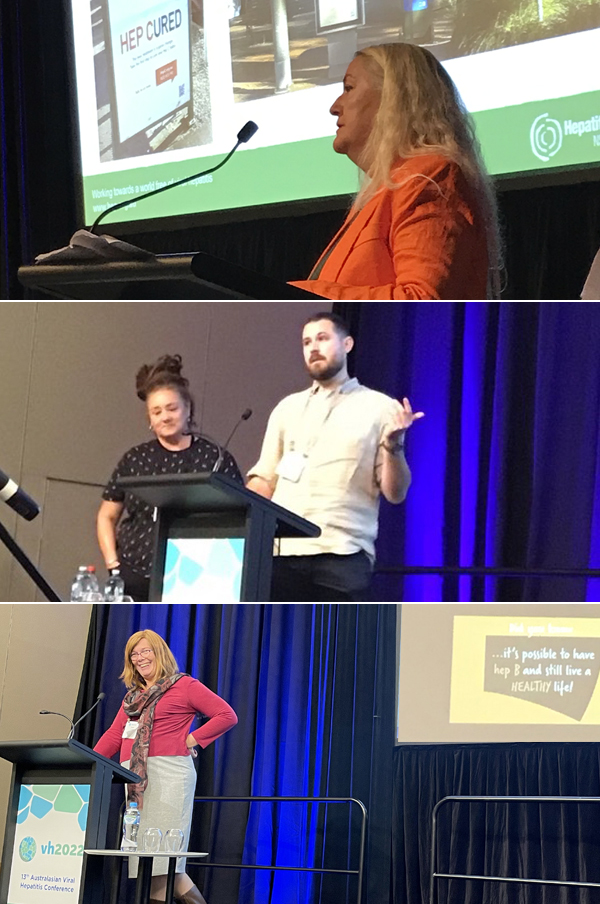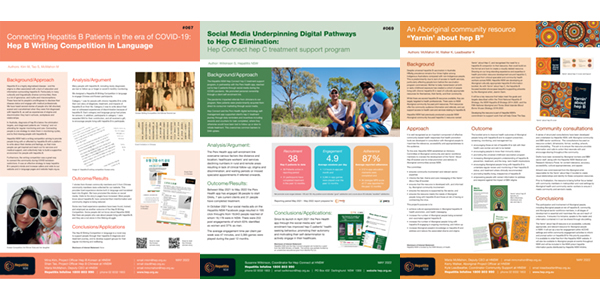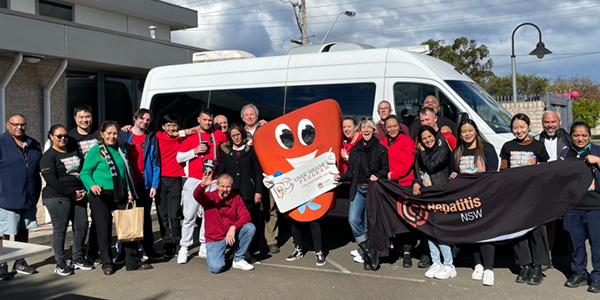The Champion #107 – June 2022
This issue:
- Viral Hepatitis Conference 2022 – Brisbane
- EC Australia’s “It’s Your Right” campaign rolling out
- Community event for liver health at Marrin Weejali

Viral Hepatitis Conference 2022 – Brisbane

The Australasian Viral Hepatitis Conference is a major annual event that supports the work of the community sector, health workforce, government and researchers towards the elimination of hep B and hep C in effected communities across Australia, and even beyond. Held this year in Brisbane, VH2022 was the first fully in-person event since the 2019 Conference. Staff from Hepatitis NSW attended, along with Hepatitis Australia and other state and territory hepatitis organisations (pictured). It was a great opportunity to network “in real life” and to hear many thought-provoking speakers.
In her address “How are we tracking against the global elimination targets for hep B and hep C?”, Hepatitis Australia’s CEO Carrie Fowlie told attendees that greater community resourcing was essential to get results at the grass roots level. She also urged delegates to move away from using the term “viral hepatitis”, instead refer to “hepatitis B and hepatitis C”. Too often, she observed, the lack of focus on hep B meant the hard work still required to achieve hep B elimination was being lost. Hepatitis B is a very different virus from hepatitis C, with different impacts and difficult challenges, and it was important for language to reflect that. Most importantly and worryingly, the lack of effort and investment in hepatitis B is being obscured behind the encouraging successes around hep C.
Capturing all elements and themes of this large three-day conference in a single article is not possible, however here is a brief overview pulled together from the reflections of Hepatitis NSW staff, including peers, in attendance.
Focus on peer engagement
There was a welcome focus on the contribution of community peer workers. Their work builds bridges between clinicians and people living with either hep C and/or hep B and offers a supported pathway into testing and treatment. The importance of peers being involved on the ground, in so many different programs and research, was clearly backed up in the data.
Peer workers were in attendance at the conference – including five from Hepatitis NSW – also being involved in key panels and discussions. One Hepatitis NSW peer worker, Grace, said it was great to see so many other organisations all dedicated to achieving the same goal, and to meet so many other peer workers at VH2022.
At the Monday afternoon panel, Peer Workers on Challenging and Addressing Stigma in Practice, in response to the question “what advice would you give new peers?”, participants responded:
- you don’t have to disclose – your way of working can create trust without oversharing;
- don’t tolerate discrimination;
- be your authentic self – people know you are speaking from experience; and
- it’s okay to have a work hat and a personal-life hat, and keep your boundaries.
Need for greater effort on hep B nationwide
Australia is not making great progress for adults living with hep B, and even the basics of care for pregnant women and their newborn babies are not always being routinely implemented.
Discussions highlighted that people living with hep B often experience stigma and hide their hep B status leading to stress. People from migrant backgrounds are already experiencing racism and discrimination due to poorer English skills, and fear more discrimination due to their hepatitis B status.
The news that “no country will achieve the goal of hep B elimination by 2030” was alarming, leading to calls for greater action and investment. Hep B is endemic in many countries with low economic development so, for there to be any progress at elimination, there must be an overall improvement of medical services and availability of a universal vaccine.
It was noted that hep B testing alone is not effective without monitoring and an involved, caring clinical system. If this is not done, the risk of hep B infection remains for everyone.
In Australia, a program of testing, monitoring and treatment for all migrants was posited as “feasible”.
Hearing about how hep B is treated in First Nations communities, especially the Northern Territory, was a highlight. Reaching people who live in remote areas can be challenging, some have no road access during the wet season, necessitating the use of two-seater planes. The process of translating information about hep B into a local indigenous language can be lengthy, especially when there are nuances that are hard to capture – for example, the word “virus” might have no Indigenous language equivalent. Since 2018, eight languages have been translated, with three more on the way.
The Tales from the Top End panel session, discussed kinship rules and who could talk to whom about hep B. As hep B is a blood-borne disease, and blood is sacred, there are rules that must be followed. One panel participant shared how, as a mother, she could talk to her daughter, sisters, mother, and aunties about hep B but not her brother, uncle or father, and that it works reciprocally with men.
Hepatitis C elimination
Even with the availability of direct acting antiviral treatments, in order to realistically achieve elimination of hep C, as it was stated time and time again, we need to deal with stigma and discrimination first.
Testing
Only a few years ago, the hugely innovative step of rolling out DBS kits began and now it has already jumped forward to the roll out of Point of Care testing on location. There are many simple, effective and innovative things going on in this space.
Custodial settings
There was a welcome focus on issues around testing and cure, and prevention of transmission in custodial settings at the conference.
It was noted repeatedly that, in Australia, being in prison is a high-risk factor for a person to get hep C. Furthermore, the number of First Nations people in prison is disturbing and disproportionate, 12 times higher than the rest of the population in Australia.
While testing and treatment programs are welcome and effective, such an approach is ‘Treatment as Prevention’. There was a strong call for harm prevention and reduction activities in prison moving forward. To this end, there needs to be an evidence-led, mature discussion around the introduction of NSPs in custodial settings to better improve the likelihood of hep C elimination amongst the prisoner population.
Tom Wright, from Justice Health and Forensic Mental Health Network (JHFMHN), was presented with The Levinia Crooks Emerging Leader Award in recognition of his work to eliminate hep C in NSW public prisons. Hepatitis NSW collaborates closely with Tom and the JHFMHN team and would like to congratulate Tom on this win – it is greatly deserved.
The National Prisons Hepatitis Network (NPHN) released a Consensus Statement on the Management of Hep C in Australia’s Prisons, in recognition of the growing importance of the prison sector in Australia’s hep C elimination efforts. The statement makes 24 recommendations and nominates key performance targets and indicators for the implementation of hepatitis C prevention, diagnosis and treatment in prisons based on the local and international scientific evidence.
Papers presented at VH2022

Staff from Hepatitis NSW presented a number of papers and sat on discussion panels at VH2022. Here is a brief overview.
HEP CURED: A Co-designed Health Promotion Partnership Program and Strategic Messaging Campaign To Increase Hepatitis C Treatment Access for People Who Inject Drugs
This was co-presented by Maria McMahon from Hepatitis NSW, with Charles Henderson (NSW Users and AIDS Association – NUAA) and Bianca Prain (Ministry of Health).
People who inject drugs are a priority population within state and national hep C strategies. The presentation discussed the highly successful HEP CURED campaign that increased access to hepatitis C information, testing and treatment for this important population.
HEP CURED messaging was developed through research with community focus groups who shared their “motivators” to seeking health services. Messaging and images developed for audience feedback, resulted in a campaign that spoke to those motivators, delivered positive messaging about treatment. The campaign images, about connection, were evaluated as meaningful and resonant. The call to action “Talk to us now” aimed to start conversations. A partnership program provided peer workers to talk with people who inject drugs about treatment, while clinical staff offered testing and treatment. [abstract]
What We’ve Learnt from 7,000 Peer Work Engagements: Developing A Gold Standard for Hepatitis C Peer Partnership Work and Linkage to Care Since 2018
Co-presented by Kyle Leadbeatter and Justine (JD) Doidge.
Hepatitis NSW’s Peer Partnership Program has been enabling improved access to hep C healthcare for priority populations in key services across NSW for many years now. In it, peer and clinical expertise are combined to develop a tailored approach to meet client needs at each service. This improves the care journey. Through experience built over 400 service visits and 7,000+ individual engagements, Kyle and JD – as the program’s coordinators – talked about how successful community hep C outreach work can be when there is a person-centred approach and strong involvement of peer workers at its core. [abstract]
Using social media to raise awareness of viral hepatitis during a pandemic
Presented by Grace Crowley.
Despite the months long state-wide 2021 COVID lockdown, Hepatitis NSW aimed to raise the awareness of hepatitis B and hepatitis C through social media platforms during NSW Hepatitis Awareness Week at the end of July. With the lockdown significantly limiting and hampering opportunities for face-to-face and public interactions, usage of social media was one of the principle means for people to exchange information. However, for the same reasons, public health discourse on social media was largely around COVID – and associated issues – often to a vitriolic level. Grace discussed how, due to a grant from NSW Communities and Justice through their Social Sector Transformation Fund, Hepatitis NSW was able to significantly increase the visibility of hep B and hep C information through several social media platforms. [abstract]
Peer workers on challenging and addressing stigma in practice
A panel discussion that included Hepatitis NSW peer workers Kiah, Will and Belinda.
This session provided a wealth of information of the important work done by peers in connecting with community, and bridge building with clinicians and services. Being the “public face” of someone with lived experience of hepatitis B and/or hepatitis C presents numerous challenges, and there was frank and candid discussion of the ups and down – but mostly ups – this line of work delivered.
Eliminating Hepatitis C: A NSW Perspective
A NSW Health Sponsored Symposium that included Hepatitis NSW peer worker Grace.
Grace spoke about her lived experience with hep C, stigma and DAA cure. She then participated in a panel discussion which covered topics ranging from stigma and discrimination, to testing and treatment.
Posters presented at VH2022

Posters have become a key component of conferences and VH2022 offered over fifty, detailing work and research from across the viral hepatitis sector. Hepatitis NSW presented three, all of which displayed information on our important community projects and resources.
- An Aboriginal community resource – Yarnin’ About Hep B
by Kerry Walker
Despite universal hep B vaccination in Australia, the prevalence of the HBs antigen remains four times higher among Indigenous Australians compared with non-Indigenous people. Hepatitis NSW had previously produced a popular NSW Aboriginal community focused hep C resource named Yarnin’ about Hep C, we recognised the need for a hep B companion to that resource. This poster discusses the development of Yarnin’ About Hep B, which we will be launching soon. - Connecting Hepatitis B Patients in the era of COVID-19: Hep B Writing Competition in Language:
by Mina Kim and Shan Teo
Hep B is a highly stigmatised disease – often associated with a lack of education and information surrounding the virus. In many culturally and linguistically diverse communities there is a lot of ignorance, and myths and misconceptions. These have led to people’s unwillingness to disclose their disease status and engage with medical professionals. Hepatitis NSW held a writing competition to give people living with, or affected by, hep B a platform to express their experience. It also offered an opportunity for people to be inspired, and to reach out for services and medical support. - Hep Connect hep C treatment support program
by Susanne Wilkinson
Hep Connect and the Perx Health digital technology self-management app was developed to support a client’s hep C treatment journey, where they otherwise would have been lost to follow-up or slow to initiate treatment. The app has daily reminders and incentives including rewards and vouchers for task completed. This simple to use technology overcomes common barriers to DAA uptake..
EC Australia’s “It’s Your Right” campaign rolling out

In early April, Eliminate C Australia (ECA) – and partner organisations – launched the It’s Your Right campaign and website.
The campaign features a combination of activities. Paid street advertising plus posters in NSPs and supporting services will be a visual prompt to think about hepatitis C treatment and will be paired with activities led by:
- peer outreach/engagement activities to increase conversations about treatment and links with trusted services;
- merchandise giveaways to engage and promote campaign messages;
- financial incentives for engagement in the testing and treatment pathway;
- online videos to share personal stories about treatment; and
- the campaign landing page to provide quick and easy information about treatment and peer services.
The It’s Your Right Campaign was developed to promote hep C testing and treatment to people who inject drugs. The campaign was designed with and for people who inject drugs, and it is working towards eliminating hepatitis C as a public health threat in Australia. It’s Your Right is supported by the Paul Ramsay Foundation via the Eliminate Hepatitis C Australia Partnership (EC Australia) and the Australian Government Department of Health.
In the Northern Territory, Queensland and South Australia. Partner organisations for the April launch were:
- Northern Territory AIDS and Hepatitis Council (NTAHC)
- Hepatitis SA
- Queensland Injectors Health Network (QuIHN).
Western Australia (in Perth and Bunbury) and the Australian Capital Territory will follow, with a launch on June 13. Partner organisations will be:
- Hepatitis ACT
- Canberra Alliance for Harm Minimisation & Advocacy (CAHMA)
- Peer Based Harm Reduction WA (PBHRWA)
The campaign will run for three months in each state and territory. All remaining states, including New South Wales in partnership with Hepatitis NSW and NUAA, will be rolled out from late July through early August.
- Campaign website >>> ItsYourRight.com.au
Community event for liver health at Marrin Weejali

At the end of May, Hepatitis NSW worked in partnership with Mt Druitt Drug & Alcohol, TAFE students, The Marrin Weejali Aboriginal Drug & Alcohol Service, and Western Sydney Local Health District to hold a Liver Health day for the Marrin Weejali community.
A great day started with a warm Welcome to Country, followed by a chat about our amazing liver and how Aboriginal people can look after themselves by looking after their liver.
For lunch, a delicious sausage sizzle and salad was served up, with raffles and prizes shared amongst the attendees. DJ Rhys, and perennial crowd pleaser O’Liver, were entertaining and encouraged everyone to chat with the friendly nurses doing liver health checks in the mobile van clinic.
- Event video >>> CLICK HERE






